Thursday 19 December 2019
Wednesday 18 December 2019
Meet AWeber’s NEW WordPress Plugin
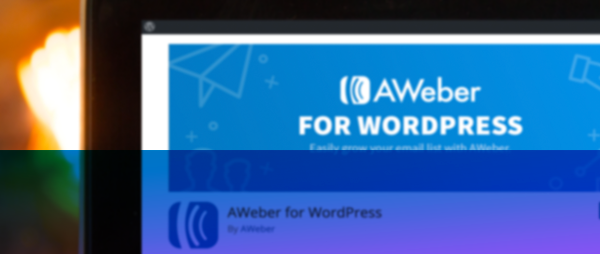
WordPress is the most popular content management system in the world. (Nearly half of all websites use it!) So it’s no surprise that it’s also one of AWeber’s most used integrations.
That’s why we rebuilt our AWeber for WordPress plugin to make it even more powerful and simpler to use to help you find greater success with email marketing. Here’s what’s new with our WordPress plugin.
It's now easier to add sign up forms to WordPress.
You now have three “easy as pie” ways to add your sign up form to your WordPress website using the AWeber plugin.
Widgets
You can add your sign up form to your WordPress theme using the widgets in WordPress, which means it’ll be added to every page on your website. For example, consider adding your sign up form to your blog sidebar or website footer.
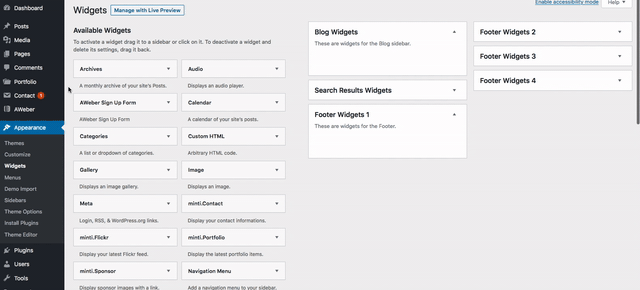
Related: How to add an AWeber sign up form using WordPress widgets
You can only place the AWeber widget in one widget area. If you want to add it to other widget areas, you can use the next method: shortcodes.
Shortcodes
Shortcodes are snippets of WordPress code that allow you to add your sign up form anywhere on your site. You don’t have to create these; WordPress automatically creates them for each of your sign up forms.
You’ll find your shortcodes inside the AWeber plugin under Forms.
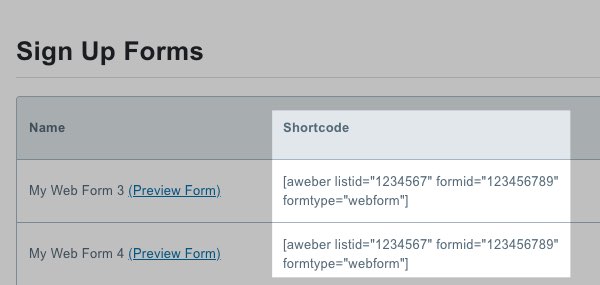
If you want to add your sign up form to your entire site, simply copy the code and paste it into a text widget.
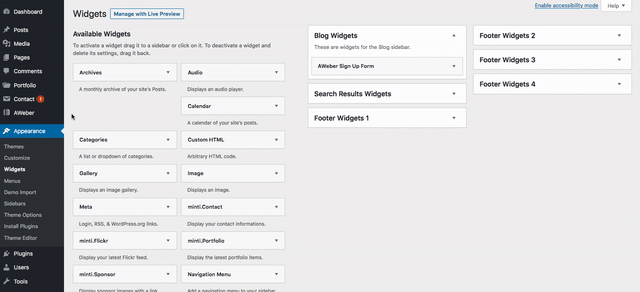
Related: How to add an AWeber sign up form using WordPress widgets
You can also add the shortcode to a specific page or blog post using the WordPress page editors, which we’ll cover next.
In the WordPress editors
To add an AWeber sign up form to a page or blog post using WordPress’s classic editor, simply paste the shortcode, or use the built-in AWeber button inside the formatting menu.

If you’re using WordPress’s Gutenberg editor, simply click the “plus” icon to add a custom AWeber block. Alternatively, you can also add a shortcode block and paste your shortcode.
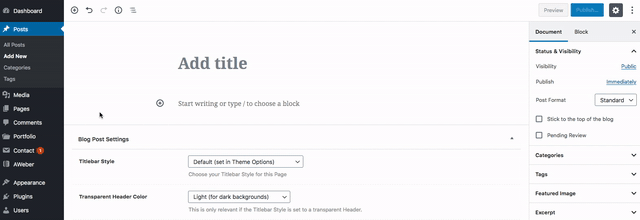
Related: Detailed step-by-step instructions on how to add an AWeber sign up form to a WordPress page or post
Automatically add commenters and WordPress users to your AWeber email list.
We’ve also made it easy for commenters and users to subscribe to your email list.
The AWeber for WordPress plugin now allows you to add a checkbox to the comment section, where users can opt into your email list when adding comments on your pages or posts.
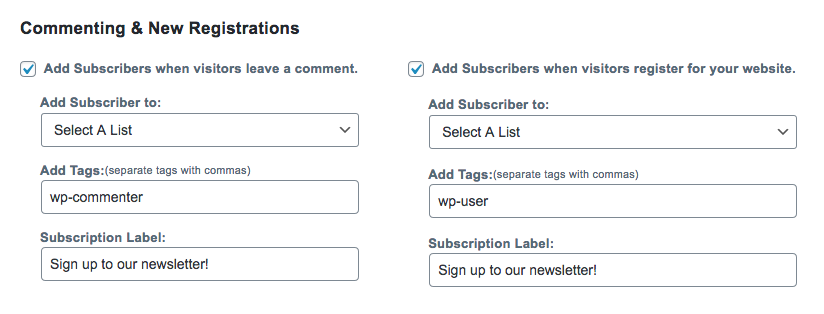
Related: How to enable the "Subscribe on Comment" feature
You can also apply tags to new commenters and users who join your list so you can segment your subscribers and send them more personalized emails in the future.
Easily see where each sign up form is being used on WordPress.
You can also quickly view where all of your forms are being used across your WordPress website.
If you ever need to remove or change the form you’re using on a particular page, you can quickly access that page right from the AWeber for WordPress plugin.
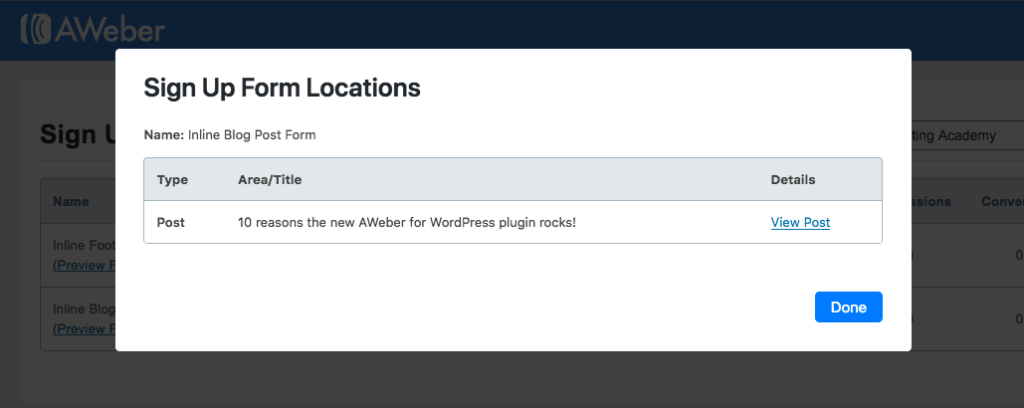
Track you sign up form performance without leaving WordPress.
One of the biggest benefits of the new AWeber for WordPress plugin is that it saves you from having to toggle back and forth between your AWeber and WordPress accounts.
Quickly track how your sign up forms are impacting your email list growth without ever leaving WordPress. You’ll learn what’s working and what’s not, so you can optimize your sign up forms for better results.
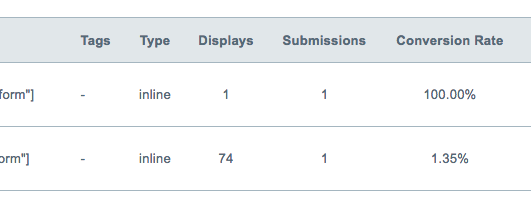
Check to make sure the plugin is installed correctly.
You don’t have to be a technical whiz to use the new AWeber for WordPress plugin.
Easily make sure your plugin is installed correctly by using the ‘System Info’ screen to view the compatibility details.
Need help troubleshooting a problem? We’ve put all of the necessary info in the System Info screen. Share this with our 24/7 Customer Solutions team and we can get you back on track in no time.
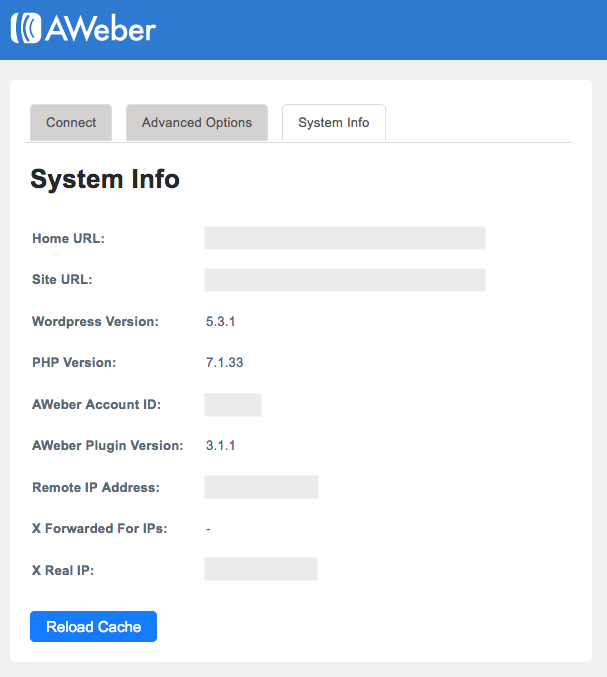
Related: How to find the technical details of your AWeber for WordPress plugin
How to get started with the new AWeber for WordPress plugin
Already an AWeber customer? Download the AWeber for WordPress plugin today, and connect it to your AWeber account.
Plus, check out a recorded demo of the AWeber for WordPress plugin inside our customer community on Facebook.
Once you’ve had a chance to try it out, we’d love to hear your feedback. Leave us a review in the WordPress marketplace.
Not an AWeber customer yet? Start your free 30-day trial today and start using the AWeber for WordPress plugin.
The post Meet AWeber’s NEW WordPress Plugin appeared first on Email Marketing Tips.
from Email Marketing Tips https://ift.tt/2PUhkqa
via IFTTT
From sexting to politics: How emoji evolved this decade

Believe it or not, the first emoji was created in 1999 by a Japanese artist, Shigetaka Kurita, who wanted to create a simple, quick, and attractive way of conveying information. At that time, Kurita was working as a developer for i-mode, an internet platform owned by Japan’s main mobile carrier, DOCOMO. Fast-forward almost 20 years and these small, yellow, emotive characters now represent a lot more than at first sight. Emoji has been referred to as a “lingua franca” — a bridging language that allows us to bypass spoken language barriers and cultural differences. But emoji aren’t just as level…
This story continues at The Next Web
from Social Media – The Next Web https://ift.tt/2Q0ruW7
via IFTTT
Tuesday 17 December 2019
Are You a “Megaphone” Email Marketer?

Think of your email list like a group of people you’ve invited over to your house for dinner. They’ve RSVP’d “yes” because they’re interested in what you’ll serve them and what they’ll learn from being there.
Now, do you stand at the head of the table with a megaphone and tell them all about you and your business? Holler about all the amazing promotions you’re running? Do you let anyone else at the table speak?
Or do you engage your guests in a lively conversation and discussion? Do you ask them what they need or want from you, or the best ways you can serve them?
“You can use email like a megaphone—where you’re just speaking loudly and not actually listening—or you can use it to create a conversation,” said AWeber’s Content Marketing Manager Jill Fanslau on the small business sales and marketing podcast Stay Paid.
One of the easiest ways to create conversation in your emails is by asking a question, said Fanslau. Ask your audience a question at least once a quarter to better understand what content they need and want from you.
The best part about engaging your audience in a conversation? “You could get your next 10 email ideas by sending one question in an email,” said Fanslau. Your subscribers’ answers could spark an idea for your next blog post, your next product, or your next lead magnet.
There are a number of ways to ask a question in your emails:
- Include a sentiment widget at the bottom of every email. (You can easily do this inside AWeber.) This gives you a quick and easy way to gauge whether your audience liked your content. Think of it like a “temperature check.”
- Send a survey. Asking your audience to complete a short survey can give you rich insights into what you’re doing right and what you can do better. (You may need to provide an incentive to get your subscribers to fill it out.)
- Reach out to individuals directly if you want to have a more personal, one-on-one conversation. If you receive great feedback, you can even ask that subscriber for a testimonial, to leave a review, or for a case study.
- Ask a simple question and encourage all of your subscribers to reply with their thoughts or feedback (good and bad). Let them know that you’ll read every single response. Reply to as many as you can so your subscribers know there’s a real person there.
For more email copywriting tips and insights on engaging your audience with email marketing, check out Fanslau's interview on Stay Paid. Or, listen on your favorite podcasting apps like Apple Podcasts, Stitcher or Google Play.
AWeber supports entrepreneurs and small businesses with powerfully-simple email marketing solutions. Get your free trial today.
The post Are You a “Megaphone” Email Marketer? appeared first on Email Marketing Tips.
from Email Marketing Tips https://ift.tt/35zPq9I
via IFTTT
Monday 16 December 2019
Friday 13 December 2019
What’s next for Sprout Social
We’re excited to share an important milestone for Sprout Social: Today we became a public company!
We started Sprout in 2010 to help our customers manage the transformation as more than 3.4 billion consumers and tens of millions of brands made social media a critical part of our lives. To do that, we’ve focused on building an exceptional platform and delivering world-class experiences for our customers.
Our mission is to help our customers harness social media to create stronger relationships with their audiences and build stronger businesses as a result. We are honored to have played a role in this journey for more than 23,000 customers to date, and we look forward to what the future of social holds.
This new stage will help us pursue our ambitious vision for the future of social business. It will help us keep building a sustainable company of which our team, customers, families and communities can be proud. And more than that, we believe it will give us the platform and additional resources to execute on our business strategies, continue to evolve with our industry and deliver the solutions our customers need to build stronger brands.
We are thankful to our team, past and present, for building what Sprout has become. To our customers, we couldn’t have reached this milestone without your trust and partnership. Thank you for being part of our journey.
Today is a proud day for our team and we can’t wait for you to see what’s next.
This post What’s next for Sprout Social originally appeared on Sprout Social.
from Sprout Social https://ift.tt/34c9FbW
via IFTTT
Thursday 12 December 2019
Wednesday 11 December 2019
5 Ridiculously Cool Ways We’ve Used AMP for Email

Everything you know about email is about to dramatically change forever.
That’s a bold statement, but it’s true...I know because my AWeber teammates and I are using revolutionary email technology that wasn’t widely available a year ago. In fact, we were one of the first marketing teams to start using it a few months ago.
I’m talking about AMP for Email.
What is AMP for Email?
With AMP (which stands for Accelerated Mobile Pages) for Email, your message is no longer a stagnant document that gathers dust inside an inbox after it’s read. It’s now a living, ever-changing experience that encourages the reader to stick around. To explore. To interact. To come back again and again. To participate.
It transforms a previously static medium into an interactive and dynamic channel in which to communicate with your audience.
That means readers can book an appointment, RSVP to an event, sign up for a newsletter, leave a product review, answer a survey or quiz, or view a live package shipping update — inside an email. They never need to open a new window or head to their browser.
AMP for Email became available in Gmail in March 2019. The tech is still in its infancy and only currently available for Gmail, Outlook, and Mail.ru users, but it will become more widespread and robust in the very near future.
And right now, AWeber is the only small business email service provider to support the new AMP for Email technology for our customers. We are continuously evolving how powerfully-simple it is for you to send AMP for Email-powered messages in AWeber.
“By adding AMP message support to our API, we’re ensuring our customers have the most up-to-date tools and technology at their fingertips to create messages that will help them connect with their customers and rapidly grow their businesses,” said Chris Vasquez, Director of Product at AWeber.
AWeber isn’t just empowering customers to use AMP for Email. We’re using it ourselves.
How AWeber is using AMP for Email in our own email marketing
Since AMP for Email launched, my teammates and I have been using the tech in our weekly email marketing newsletter, FWD: Thinking. In fact, anywhere from 25% to 30% of all clicks on the newsletter’s main call-to-action (CTA) come from readers viewing an AMP-enabled version. (We still send an HTML version every week, too, for people not using Gmail, Outlook, or Mail.ru.)
We’ve only scratched the surface of what we can do with the technology, but it’s exciting to experiment to see which AMP elements drive the most engagement from our newsletter readers. Keep reading for a list of some of the interactive and dynamic AMP for Email content we’ve tested so far.
AMP for Email: Image Carousel
We showed off our free, seasonal GIF guides in interactive image carousels inside the newsletter. As a FWD: Thinking reader, you could easily click or tap the arrows inside the email to scroll through a handful of GIFs.
If you weren’t viewing the AMP-enabled version of the newsletter, you would have seen a single GIF at the top of the email. You had to click into the blog post to view more.
Big news! AWeber just added the image carousel into our drag-and-drop email builder. Just drag it into your email and add up to 6 images. You can use it today! Not an AWeber customer yet? Sign up for a free trial of AWeber.
We have tested the image carousel with two GIF guides so far:
Fall GIF Guide, August 2019

Check out AWeber's Fall GIF Guide.
Holiday GIF Guide, November 2019

Check out AWeber's Holiday GIF Guide.
The percentage of readers clicking the AMP image carousel element increased by 28% from our Fall GIF Guide to our Holiday GIF Guide.
The Holiday GIF Guide could have been more popular among AMP viewers, but we doubted that could account for such a drastic increase.
One of the main reasons we can surmise for the significant boost in engagement? In the short time between the two emails, Outlook made AMP for Email available and GSuite rolled out AMP support so it was turned on by default.
Our hypothesis: The pool of potential FWD: Thinking readers seeing AMP for Email elements in their inboxes (desktop and mobile) is increasing every single month as more Internet Service Providers make it available. The percentage of people interacting with AMP elements will only continue to go up.
AMP for Email: Feedback Form
We’ve always collected questions and feedback from our readers. It helps pinpoint our readers’ biggest pain points and spur new educational content ideas.
In the past, the CTA for our newsletter’s feedback form took you to a separate webpage to fill out. With AMP for email, you can now submit your question directly into the email. No leaving the inbox! This reduces friction for the user and increases our likelihood of garnering responses.
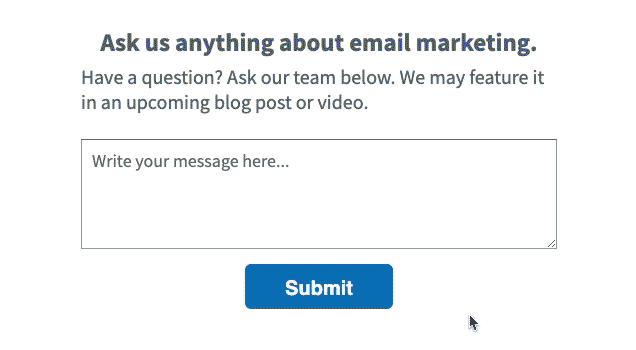
Our readers who received the AMP-enabled version of the newsletter noticed the change. One subscriber, Andre V., even wrote into the feedback form:
I have a question about this form in the email... Does it submit? What wizardry is this?
Andre, meet AWeber’s sorcerer, AMP for Email.
AMP for Email: Sentiment Widget
AWeber gives all customers the option to add sentiment widgets to their emails. You can think of them as quick “temperature checks” to make sure your subscribers find your content useful or not.
Previously, the sentiment widget would take you to a separate landing page outside of your inbox. There, you could add more info about why you liked or didn’t like the email.
AMP for Email, however, allowed us to make this element interactive and dynamic. Not only can you click on the smiley or frowny face within the email, but you can also write your response inside the message, too.
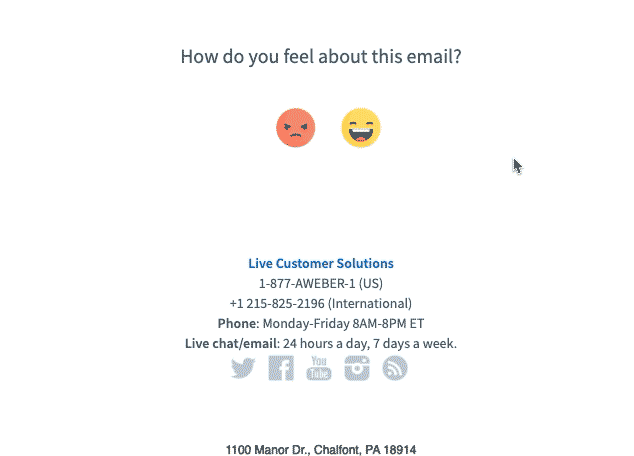
Plus, you can find out how many other subscribers felt the same as you. If you leave the message, come back later, and click the face again, the numbers may update depending on how many people interacted with the AMP element while you were gone.
AMP for Email: Polls and Quizzes
We recently conducted a quiz inside our FWD: Thinking newsletter using AMP for Email. (It’s a lot like the quizzes you see inside Instagram or Facebook stories.)

After you clicked on an answer, you were automatically given the correct answer and the percentage breakdown of how many other FWD: Thinking subscribers chose each answer.
Just like with our AMP for Email sentiment widget, if you left the newsletter and came back later, you could see updated percentages of subscribers’ answers.
So what happened if you didn’t have access to AMP? You were taken to a separate landing page that gave you the answer to the quiz. However, you never got to see the dynamic breakdown of subscriber percentages clicking on each answer.
We also conducted a poll to see if people were sending Black Friday and/or Cyber Monday email campaigns this year — and we offered the final results in a followup email the next week.
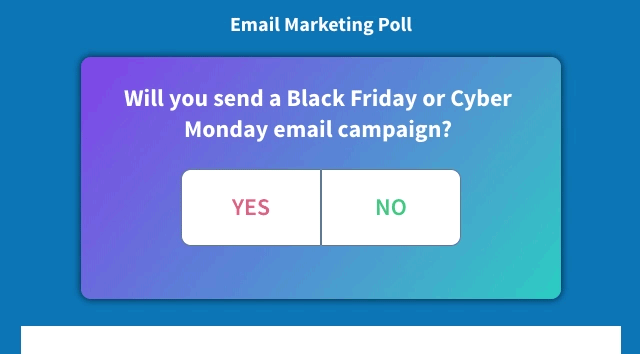
The experience for AMP users was the same as the quiz. You received a percentage breakdown of subscribers who were or were not sending Cyber Weekend email campaigns. If you didn’t have AMP, you were sent outside of the inbox to a separate landing page.
Overall, for both the quiz and the poll, we saw about 20 to 25% of the total clicks come from people using the AMP for Email element.
Next Steps: AMP for Email inside AWeber
Right now, getting set up to send AMP for Email messages takes a bit of work since you need to authenticate your sending domain and apply to be an AMP for Email sender in Gmail, Mail.ru, and Outlook. (You can see the full directions here.)
But once you’re all set up to send AMP for Email, AWeber’s product team is making it as seamless and as powerfully-simple as possible for our customers to send AMP messages through our platform. We are currently the only small business email marketing provider that offers AMP for Email capability in our API, and we have already launched our first AMP element — the image carousel — in our drag and drop email builder.
For a rundown on how to use AMP for Email in AWeber, sign up for our free webinar on January 17.
The post 5 Ridiculously Cool Ways We’ve Used AMP for Email appeared first on Email Marketing Tips.
from Email Marketing Tips https://ift.tt/2qLXdlA
via IFTTT
Sprout Social named one of Glassdoor’s Best Places to Work in 2020
I’m thrilled to announce Sprout Social has been recognized as one of Glassdoor’s Best Places to Work in 2020. This is the third year we’ve received this recognition, and we’re honored to be included in this notable roundup once again.
Every year, Glassdoor releases a list of companies who are deemed Best Places to Work by their employees. The winners are based entirely on employee feedback that is shared anonymously on the Glassdoor platform. This year, we were included on the list that recognizes United States-based companies with less than 1,000 employees.
If we’ve learned anything from the past year, it’s that the ability to adapt to change goes hand-in-hand with growth. As our team continues to expand, both nationally and globally, we’ve updated our policies and programs to better support everyone on Team Sprout. Notable highlights this year included updating our parental leave policy (all eligible employees now receive a full 16 weeks of paid leave), expanding our diversity, equity and inclusion initiatives and introducing company-wide Focus Days and other new approaches to how we work.
These changes are a result of the culture we’ve been able to create that promotes open communication and feedback. We couldn’t be more proud of our team for sharing their thoughts and doing their part to make Sprout the place that it is today—a great place to work.
So what exactly makes Sprout Social the workplace that it is today? Below are a few testimonials from current employees who shared their thoughts on Glassdoor:
“The culture at Sprout is the best you can find in a workplace. From day one I felt welcome and respected. I continuously tell my friends that I genuinely cannot wait for work the next day. Sprout treats its employees better than any other company I have been at.”
— Sales Development Representative, Sprout Social
“Sprout truly cares about its people, in every sense. I’ve never worked at a company that is as thoughtful and intentional about representation and inclusion. Everyone here wants to see you succeed and the mentality is that we’re all one team, working together to provide value to our customers.”
— Anonymous Employee, Sprout Social
“Sprout lives up to its values so much. And since those values are identical to mine, I feel like I’ve found a perfect fit for a workplace. Pros include working with incredibly talented and smart people, having a supportive team and manager, and an environment that focuses on inclusivity. I genuinely enjoy going to work each day and doing what I do.”
— Solutions Engineer, Sprout Social
I want to personally thank everyone on Team Sprout for their contributions in making our culture what it is today—award-winning. We have a world class team and I’m excited to see what the year ahead has in store for us.
Want to join us? We’re hiring.
This post Sprout Social named one of Glassdoor’s Best Places to Work in 2020 originally appeared on Sprout Social.
from Sprout Social https://ift.tt/2qIWRfx
via IFTTT
Tuesday 10 December 2019
Monday 9 December 2019
Social Spotlight: how the ASPCA uses social to drive action
Welcome to the Social Spotlight, where we dive deep into what we love about a brand’s approach to a specific social campaign. From strategy through execution and results, we’ll examine what makes the best brands on social tick — and leave you with some key takeaways to consider for your own brand’s social strategy.
Overview
We all know social is a powerful platform for great storytelling, but the real secret sauce is when that great storytelling is paired with the immediate connection social offers. This is especially true for nonprofits like the American Society for the Prevention of Cruelty to Animals, or the ASPCA, which uses social to drive awareness of its causes, exposure for animals in need and fiscal support to operate its programs. Because it relies on donations from the public to fund much of its work, the ASPCA expends great effort to connect with animal lovers through the stories of the animals it helps (and the humans who love them). Social allows the organization to tie those stories directly to actions of support: donations, adoptions, lobbying and awareness.
Analysis
Founded in 1866, the ASPCA is the oldest humane society in the United States and supports the mission that “animals are entitled to kind and respectful treatment at the hands of humans and must be protected under the law.” As one of the largest animal rights organizations in the world, the ASPCA uses its platform to support the work of shelters and animal rights organizations everywhere and social media has become one of its key channels for doing so. According to a report the ASPCA released in 2018, 86% of animal shelters and rescue groups surveyed say social has increased general awareness, while 66% say it has increased adoptions overall and 55% say it has made it easier to place hard-to-adopt animals like seniors and disabled pets.
But identifying exactly why those numbers are so impressive, and how it relates to other nonprofits and their efforts, is where this Spotlight gets really interesting. Like many organizations dedicated to making the world a better place, the ASPCA has emotional stories to tell. But how it organizes those stories across social, executes against specific objectives for each type of story and grows and expands its relationships with different audiences is what makes the ASPCA’s social strategy especially strong. For instance, adoptable pet stories are most relevant to those with the ability and means to adopt in this moment, but shelter success stories will appeal to just about any animal lover, and animal care tips will be relevant to all animal owners, regardless of how they came to own their pets. Creating multiple “ways in” emotionally expands the relevance of the ASPCA’s messages, which opens up new audiences and potential sources of support for the organization’s mission.
- Goals: The ASPCA’s goals for social are as multifaceted as its objectives as an organization. The most foundational is awareness for the plight of homeless and abused animals in America, which drives a significant percentage of the content across all social platforms. Video is the primary format for this type of storytelling, and the ASPCA does a great job of profiling how its efforts bring people and animals in need together. Video also enables the social team to use highly emotional levers like music, narration and graphics to create moods for the content, ranging from solemn to urgent, to celebratory.
- Engagement is another visible goal for the ASPCA’s social efforts, specifically driving donations. The organization takes full advantage of the social platform functionality that makes giving relatively simple, including Facebook fundraisers (which it also encourages individual followers to set up) and Instagram’s recently added Donation sticker, which allows users to add a direct donation option to their personal Stories. What I appreciate about the ASPCA’s donation calls to action is that they are interspersed with storytelling, so there is plenty to keep audiences engaged with the organization’s mission until they are ready to make a donation or adopt an animal. Finally, the ASPCA seeks to educate its audiences about a number of topics related to animal welfare. One of my favorites is Paws-On Projects, a Facebook video series about how to make homemade pet treats, because it’s relevant to any pet owner and provides viewers with low-lift inspiration to be more involved in the lives of the animals they love. The ASPCA also offers live Q&A opportunities on social for those interested in fostering or adopting a pet but looking for information on the process.
- Offline connection: Driving donations is the key offline connection social provides for the ASPCA, and as mentioned above, the org is taking full advantage of onboard donation tools on the various social platforms. My favorite move is that rather than limit the calls to donate to its own channels, the ASPCA makes it frictionless for individual supporters to solicit donations from their own family, friends and followers by creatively promoting the use of Facebook’s Fundraiser feature and Instagram’s Donation stickers. This not only helps widen the net of potential donors but also helps the ASPCA avoid “ask fatigue” by over-saturating its own audiences with requests.
- Key channels: Instagram – I love how organized and easy to navigate the ASPCA’s Instagram profile is. Story Highlights are categorized by animal type (i.e. Puppies, Horses, Farm) and engagement (Donate, Take Action, Q&A). It’s easy to find exactly the information you’re looking for in an approachable, actionable way. YouTube: The ASPCA’s YouTube page is a repository of great video storytelling, including adoption stories, profiles of donors and supporters, and documentary-style content about how the ASPCA staff cares for animals in recovery. The content is rich in educational information and emotional resonance, and gives a wide-range view into all that the organization does to support the whole lives of animals. Facebook: Despite Facebook still being the world’s largest social platform, it feels rare today for brands to be creating content explicitly for that channel. But Facebook is still where users share the emotional stories that resonate with them, so it’s a must for nonprofits. The ASPCA does a nice job of playing to the strengths of Facebook, particularly sharing and driving donations through the Fundraiser feature.
Takeaways
No one would say that nonprofit marketing is easy, but social has certainly made it easier to spread awareness and galvanize support for worthy causes. One advantage nonprofits will always have is the altruistic nature of their promotional content – the goal is to help others, not to generate profit for a private company. It’s the responsibility of the organization to capitalize on this advantage and create content that connects emotionally and drives action.
TL;DR:
- Don’t leave us hanging! If you share a call to action for help with a specific situation, invest time and resources in creating follow-up content that shows your audience the impact their support had. Everyone loves a good success story, especially if they had a hand in the happy ending.
- Be a community resource. Make your expert staffers available to all subsets of your audience, from those ready to open their wallets to those just trying to satisfy a curiosity or learn something new about your cause. Every piece of content is an opportunity to create a stronger bond, no matter where someone is in their journey with you.
- Get organized on social. More and more people want to learn about causes on social media rather than your website, so make that as easy as possible for them by keeping your content organized. While the ASPCA has Instagram nailed, I’d love to see them create a more easily navigated experience for all the great content they’re publishing on YouTube. A couple of playlists can go a long way.
- Activate your audience! Most social platforms have built donation capabilities into their experiences, so don’t just rely on your own followers for donations. Encourage them to engage their personal networks on your behalf by soliciting support from their family and friends for a cause they believe in.
This post Social Spotlight: how the ASPCA uses social to drive action originally appeared on Sprout Social.
from Sprout Social https://ift.tt/2Pt6JCu
via IFTTT
Friday 6 December 2019
Thursday 5 December 2019
Twitter to follow Facebook and Instagram with new anti-NSFW guidelines

Over the past year, social networking platforms Facebook and Instagram have made it almost impossible for NSFW artists to exist on the platforms in their efforts to ‘clean up’ the sites. The measures employed have ranged from banning any discussion around “sexual preference,” “sexual roles,” “breasts,” and “buttocks” to the tech giant’s latest stunt in restricting solicitation that involves “sexual emoji or emoji strings.” The trend of deteriorating conditions for NSFW artists to make a living online first started last year when Tumblr announced that it would block anything it considered to be adult-rated visual content. Now, Twitter, a platform…
This story continues at The Next Web
Or just read more coverage about: Facebook,Instagram,Twitter
from Social Media – The Next Web https://ift.tt/2rgAuyb
via IFTTT
Wednesday 4 December 2019
Tuesday 3 December 2019
Monday 2 December 2019
Report: TikTok limited the reach of users with visible disabilities
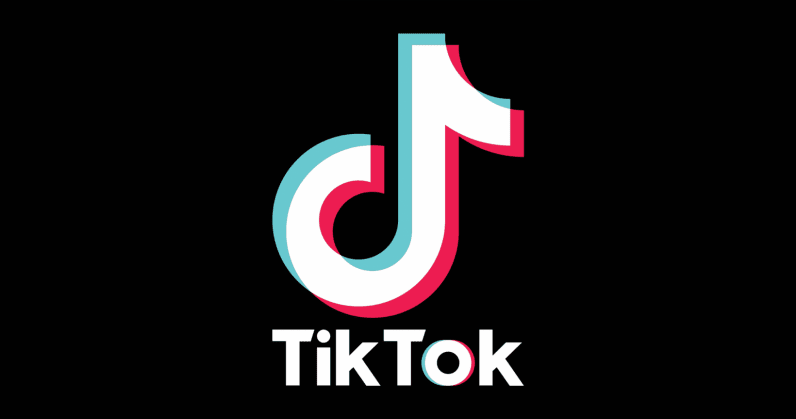
TikTok, the social media sensation du jour, has apparently been hobbling users who have physical disabilities. It did so in a misguided attempt to shield these people from bullying — heavy emphasis on the word “misguided.” According to a report from Netzpolitik, leaked documents reveal TikTok had special rules in place for those with some visible or obvious form of disability or disfigurement. These users include user with “autism… Down syndrome… facial disfigurement… [and] disabled people or people with some facial problems such as a birthmark, slight squint and etc.” I say “visible or obvious” because TikTok groups such individuals under the…
This story continues at The Next Web
from Social Media – The Next Web https://ift.tt/2Y86jFz
via IFTTT